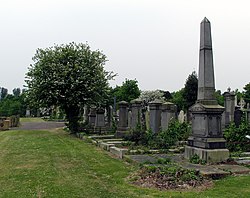Belfast City Cemetery
 From Wikipedia - Reading time: 8 min
From Wikipedia - Reading time: 8 min
| Belfast City Cemetery | |
|---|---|
 | |
 | |
| Details | |
| Established | 1869 |
| Location | |
| Country | Northern Ireland, UK |
| Type | Public |
| No. of graves | 226,000 |
Belfast City Cemetery (Irish: Reilig Chathair Bhéal Feirste) is a large cemetery in west Belfast, Northern Ireland. It lies within the townland of Ballymurphy, between Falls Road and Springfield Road, near Milltown Cemetery. Burial records have been fully digitized and are searchable online.[1]
History
[edit]Following the Belfast Burial Ground Act (1866), the cemetery was opened on August 1, 1869 as a cross denominational burial ground for the people of Belfast, a fast-growing Victorian town at the time. The land was purchased from Thomas Sinclair. The cemetery features cast iron fountains and separate Protestant and Catholic areas. Many of Belfast's wealthiest families have plots in the cemetery, particularly those involved in the linen trade. Since its opening in 1869 around 226,000 people have been buried in the cemetery.
In 1874 an area was set aside for Belfast's Jewish residents.[2] In this setion there is a memorial to Daniel Joseph Jaffe, father of Otto Jaffe, a Jewish linen exporter and former Lord Mayor of Belfast. Above the old Jewish entrance to the cemetery, Hebrew writing can clearly be identified.
In 1916 an area was dedicated to soldiers who died serving in World War I, when 296 Commonwealth service personnel were buried in the cemetery. Those whose graves could not be marked by headstones are listed on Screen Wall memorial in Plot H.[3] Many of the United States Army personnel killed in the sinking of HMS Otranto in 1918 were buried in the graveyard. After the war their bodies were exhumed and repatriated to the United States.
In World War II, 274 Commonwealth service personnel, 5 of them unidentified, were buried in the cemetery, besides 3 Norwegian nationals whose graves are also maintained by the Commonwealth War Graves Commission.[3]
Developments
[edit]As the frequent target of vandalism, many of the British Army soldiers' headstones were moved to Sir Thomas and Lady Dixon Park. In 2012, continuing vandalism of the World War I Screen Wall has led to proposals to move it to another part of the cemetery.[4] Due to its historical importance, the cemetery is a popular tourist attraction in Belfast, with guided tours available.
As part of a major heritage project the cemetery began a major upgrade in the early 2020s. This included the building of a visitor centre which has various displays about the history of the cemetery.[5]
Notable interments
[edit]- Sir Robert Anderson, 1st Baronet - politician, former Lord Mayor of Belfast.
- Robert Hugh Hanley Baird - businessman
- Margaret Byers - educator, activist, social reformer, missionary, and writer [6]
- Sir George Clark, 1st Baronet - shipbuilder
- Samuel Cleland Davidson - inventor and founder of Belfast Sirocco Works[7]
- Denis Donaldson - Former IRA member and Sinn Féin politician; killed as a British spy.
- Vere Henry Louis Foster - educationist and philanthropist [8]
- Tom Gallaher - tobacco merchant
- Edward Harland - shipbuilder and politican [9]
- James Henderson - Unionist politician, former Lord Mayor of Belfast.
- Daniel Joseph Jaffe - Built Belfast's first synagogue; father of Otto Jaffe, former Lord Mayor of Belfast.
- Florence Augusta Lewis - mother of C.S. Lewis[10]
- Robert Wilson Lynd - author [9]
- William Henry Lynn - architect [11]
- Thomas Macknight - Political author and biographer.
- Francis Maginn - missionary
- Valentine McMaster - Victoria Cross (VC) recipient (Indian Mutiny).
- Bernard McQuirt - VC recipient, Indian Mutiny. (Grave in pauper plot unmarked; commemorative headstone at Donaghcloney, County Armagh).
- Rinty Monaghan - boxer [12]
- William Pirrie, 1st Viscount Pirrie[13]
- Elisha Scott - football player [14]
- Robert Thompson - politician
- Sam Thompson - playwright
- William Whitla - physician and politician [15]
References
[edit]- ^ "Search for a burial record". Belfast City Council. Retrieved 8 November 2024.
- ^ Irish Gravestone Inscriptions, Tracing your Irish Ancestors: Introduction
- ^ a b CWGC. "Belfast City Cemetery | Cemetery Details". CWGC. Retrieved 8 November 2024.
- ^ "Vandals may force memorial move". BBC News. 17 April 2012.
- ^ "City cemetery visitor centre now open". Belfast City Council. Retrieved 12 June 2023.
- ^ "Margaret Byers - A Century Of Women". www.acenturyofwomen.com. Retrieved 8 November 2024.
- ^ P&P (22 July 2022). "Belfast's Extraordinary Inventor - Samuel Davidson (Sirocco Works)". Belfast Entries. Retrieved 8 November 2024.
- ^ "The Story of Belfast City Cemetery". Belfast Entries. 23 June 2021. Retrieved 8 November 2024.
- ^ a b "The Dictionary of Ulster Biography". www.newulsterbiography.co.uk. Retrieved 8 November 2024.
- ^ "Florence Augusta "Flora" Hamilton Lewis ..." www.findagrave.com. Retrieved 8 November 2024.
- ^ https://www.dib.ie/biography/lynn-william-henry-a4967
- ^ "John Joseph "Rinty" Monaghan (1918-1984) - Find a..." www.findagrave.com. Retrieved 8 November 2024.
- ^ "Viscount William James Pirrie (1847-1924) - Find..." www.findagrave.com. Retrieved 8 November 2024.
- ^ "Elisha Scott (1893-1959) - Find a Grave Memorial". www.findagrave.com. Retrieved 8 November 2024.
- ^ "The Dictionary of Ulster Biography". www.newulsterbiography.co.uk. Retrieved 8 November 2024.
Further reading
[edit]- Hartley, Tom (2014). Belfast City Cemetery: the history of Belfast, written in stone (2nd ed.). Belfast: Blackstaff Press. ISBN 978-0-85640-924-0.
External links
[edit] Media related to Belfast City Cemetery at Wikimedia Commons
Media related to Belfast City Cemetery at Wikimedia Commons- Belfast City Cemetery Archived 2007-09-29 at the Wayback Machine
 KSF
KSF